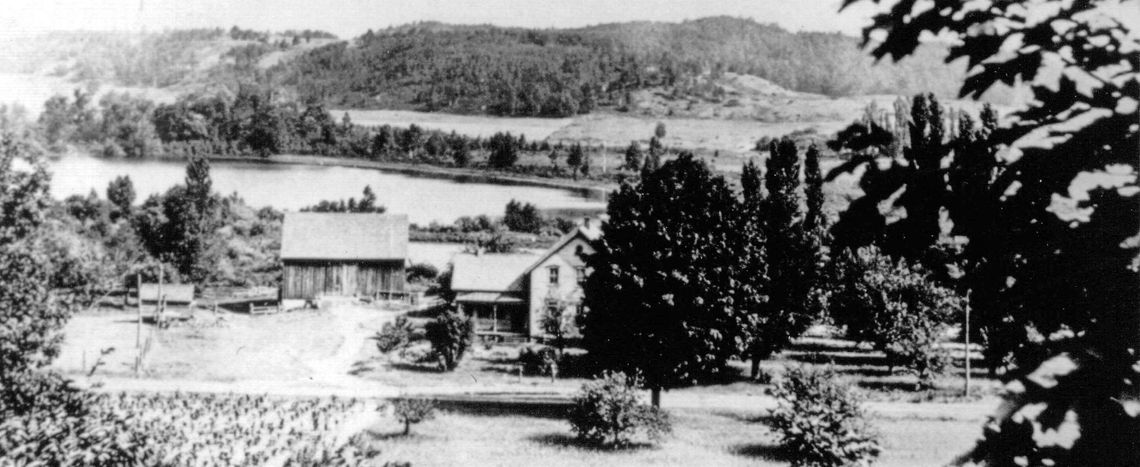This continues a series adapted from the book, “A Port Oneida Collection,” Volume 1 of the twopart set, “Oral History, Photographs, and Maps from the Sleeping Bear Region,” produced by Tom Van Zoeren in partnership with Preserve Historic Sleeping Bear. Here we conclude our look at the Goffar Farm, along M-22 on Lake Narada. Picking up after the passing of Olive Manney-- Following Olive’s passing, the farm was purchased by Glen Arbor dentist Leo Roman, whose family used it as a weekend retreat. With the advent of Sleeping Bear Dunes National Lakeshore, Dr. Roman sold the place to the Park with a 25-year retention-of-use provision. After he died in 1984, the family sold the retention rights to a company that rented it out.
One of the last occupants before the retention expired was Breanna Malm, who provided the following perspective at the 2010 Port Oneida Fair. Starting with how long she had lived there, Breanna answered, wistfully, “My whole life--thirteen years. I love it. It’s really a great place. It’s going to be hard moving out, because I’ve spent my whole life there. It’s just a beautiful place to live. It’s wide open. There’s like a bunch of places you can go just to explore more things. I love Narada Lake. It’s so beautiful at night, watching the sunset. It’s just pretty . . .
“We have a rowboat that we put out every summer, and we row out there. Sometimes I put my bathing suit on and go out there and jump out in the middle of the lake — Not up front, because it’s swampy, and the bottom is really mucky; (but in the middle) you can’t really reach because it is really deep.
“One day I was just out there. I was on my stomach on the dock, and I was looking down in the water. My face was really close to the water, and I was kind of zoned out. I was in my own little land, ‘cause it was a nice day. I looked down. I looked in the water, and I just saw a huge tail just swim underneath the dock! And it wasn’t like a beaver, or like an otter or something like that. It was a snake tail. But nobody really believes us, because it’s hard to believe.”
Breanna estimated that the snake was eight inches in diameter. Her father also saw it one time, and estimated that it was 12 – 15 feet long.
As Breanna noted, Narada is very deep for a small lake. In addition to being far down, the bottom is very soft; almost undefined. Port Oneidan Marilyn Eckerdt remembered some of the men going out in a boat with ropes and chains one time to find the bottom. It was finally declared to be “bottomless.”
Another interesting wildlife find from Lake Narada was an elk antler pulled out of the mud along the south edge by George Shalda when he was a boy in the early 1900s. As Laura Basch told it, “I think he probably was just ploddin’ around like we used to do a lot, and he come upon those horns. Probably something sticking out and then was curious about it, and that’s what he found.” Apparently it was studied and definitively identified as an elk, somehow preserved in the muck, since elk have not been here for a long time. The item ended up on display in Shalda’s Store (at the corner of M-22 and County 669) for many years.
Like its sister, Shell Lake, Narada has had many names over the years, even aside from any used by the Native Americans. Most of the earliest maps do not even label it; however, several of the older people interviewed remembered it as Prause Lake, since the Prause family owned it for quite a while. Prior to that the Goffars owned it, so it may well have been referred to by their name. Later, after the Manneys acquired it, it was indeed known as Manneys’ Lake. Finally someone, reportedly Olive Manney, who took an interest in Asian culture, named it “Lake Narada” for a Vedic sage/musician/ storyteller who brings enlightening wisdom. Perhaps she saw the enchanting lake in a similar way.
That is how old-time Port Oneidans usually referred to Narada during my interviews, and it is how it was labeled on maps until several decades ago. Unfortunately, someone apparently placed it on a map at some point with the words transposed to the less melodic “Narada Lake”; and that is what seems to have taken hold. In this book we stick with the old way . . .








